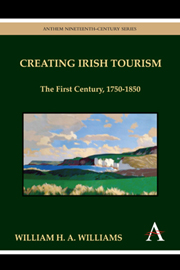Chapter 9 - On the Road—In Search of Ireland
from Part III
Published online by Cambridge University Press: 05 March 2012
Summary
Tourist Space in Ireland
As the preceding chapters have made clear, the Irish Tour involved more than the picturesque. In order to understand the complexity of the tourist experience, it is necessary to investigate “tourist space” in Ireland. The term as used here considers the parts of a country in which tourism occurs, and how deeply into a country tourism may penetrate. Tourist space may be thought of in terms of traveling to, traveling through and/or traveling into a country. Each involves very different kinds of tourist experiences.
Much tourism today involves the most limited form of tourist space: travel to a country. People fly to a location, enjoy a resort, shop around a city, attend a convention or international sporting event, and fly out again. Even on “side trips” to famous ruins or scenic attractions, visitors may move quickly to and from their destinations, encapsulated in buses, planes or helicopters. This sort of point-to-point travel, whatever its joys and rewards, offers a very limited experience of the host country, treating it like a series of unconnected “dots” or sites.
Traveling through a country invariably takes more time. In following a well-trod itinerary with little deviation from the guidebook or the route established by the tour guide, this sort of trip may allow the tourist enough time to observe bits of the countryside and the towns along the way; to make brief stops at minor attractions; to visit enough cafes, inns, or food stalls; and talk to enough natives to get some sense of the local as opposed to the international.
- Type
- Chapter
- Information
- Creating Irish TourismThe First Century, 1750–1850, pp. 165 - 182Publisher: Anthem PressPrint publication year: 2010



